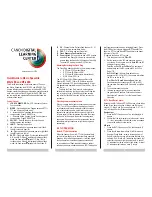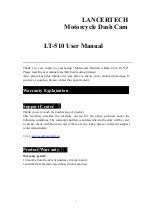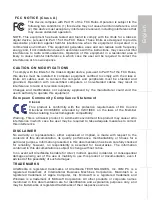
Installation
1. Aim the umbrella bracket at the Bracket
Mounting Hole (6) of the flash body. Then,
screw the two Bracket Mounting Bolts (28)
into the Bracket Mounting Hole (6) and
tighten them.
2. Insert the photo umbrella.
3. Tighten the bolt to fix the photo umbrella.
Installing the Umbrella Bracket
2. Screw the Camera Adjusting Knob
(25) into the camera’s tripod socket
and tighten it.
3. Adjust the Angle Adjusting knob (23)
to let the camera lens pass through
the ring flash.
Installing the Camera
1. Aim the Height Guide Rail (21) at the Bracket Mounting
Hole (6) of the flash body. Then, screw the two Bracket
Mounting Bolts (28) into the Bracket Mounting Hole (6) and tighten them.
Installing the Diffusion Cover.
1. Put the diffusion cover on the flash body
and make the claws of the cover correctly
fall into the hollow periphery of the body.
2. The diffusion cover can be detached by
lifting it lightly.
Battery Pack
Features
1. This flash unit uses Li-ion polymer battery which has long runtime. The available charge-
and-discharge times are 500.
2. It is reliably safe. The inner circuit is against overcharge, overdischarge, overcurrent, and
short circuit.
3. Take only 2.5 hours to fully charge the battery by using the standard battery charger.
Cautions
1. Do not short circuit.
2. Do not expose to rain or immerse into water. This battery is not water proof.
3. Keep out of reach of children.
4. No over 24 hours’ continuous charging.
5. Store in dry, cool, ventilated places.
6. Do not put aside or into fire.
7. Dead batteries should be disposed according to local regulations.
8. If the battery had ceased using for over 3 months, please make a full recharge.
Loading and Unloading the Battery Pack
Loading: (1)Put the battery pack into the battery
compartment. (2)Push the battery pack to the left
until it is locked with a click sound.
Unloading: (1) Push the Battery Locking Key (7)
downward. (2) Push the battery pack to the right
to unload it.
Battery Level
Battery Level
≥
25%
7%<Battery Level<25%
Battery Level
≤
7%
Battery Level Indication
Note: When the LED light is on, the battery voltage is lower and the battery level indicator cannot
display the correct amount.
Battery Level Indication
Not Displayed
Displayed
Blinking
Flash Times (1/1 step)
Approx.100~400
Approx.30~100
Approx.<30
When the LCD panel shows “OF”, it means that there is no flash output and the flash
cannot be fired.
3. M Mode
Press MODE Selection Button (16) to enter M mode. In this mode, you can set the flash
unit onto your camera hot shoe or your trigger hot shoe for firing. During shooting, adjust
the power output and press the camera shutter, then the camera flash will fire a flash under
the camera synchronous signal. In this mode, the light sensor is off.
4. S1 Mode: S1 Slave Triggering Mode
Press Mode Selection Button (16) to enter S1 mode. In this mode, the flash unit can
function as a slave flash for creating multiple lighting effects. It is respectively applicable to
manual flash environment.
In S1 mode, the flash unit will fire synchronously when the master flash fires, the same
effect as that by the use of radio triggers.
5. S2 Mode: S2 Slave Triggering Mode
Press Mode Selection Button (16) to enter S2 mode. In this mode, the flash unit can
function as a slave flash for creating multiple lighting effects. It is respectively applicable to
TTL system.
In S2 mode, the flash unit will ignore a single “preflash” from the master flash and will only
fire in response to the second, actual flash from the master.
6. RPT Mode: Stroboscopic Flash
Press Mode Selection Button (16) to enter RPT mode. With stroboscopic flash, a rapid
series of flashes is fired. It can be used to capture multiple images of a moving subject in a
single photograph.
You can set the firing frequency (number of flashes per sec. expressed as Hz), the number
To avoid overheating and deteriorating the flash head, do not use stroboscopic flash
more than 10 times in succession.
Maximum Stroboscopic Flashes:
1/4
1/8
1/16
1/32
1/64
1/128
30
50
70
80
99
99
2
4
70
80
99
99
2
2
7
80
99
99
2
2
4
16
99
99
2
2
3
8
99
99
2
2
3
6
99
99
1
2
3
5
25
99
Flash Output
Hz
1
2
3
4
5
6
7
1/4
1/8
1/16
1/32
1/64
1/128
1
2
2
5
15
99
1
2
2
4
10
99
1
2
2
4
6
99
1
2
2
3
6
99
1
2
2
3
5
99
1
2
2
3
5
36
1
2
2
3
5
20
Flash Output
Hz
9
10-11
12-13
13-15
15-19
20-99
8
1/1
1/1-0.3
1/1-0.7
1/2
1/2-0.3
1/2-0.7
1/4
…
OF
1/2+0.7
1/2+0.3
1/4+0.7
1/4+0.3
…
Figures displayed when reducing flash output level
→
←Figures displayed when increasing flash output level
Using the Flash
1. Power Management
Press ON/OFF Power Switch for 2 seconds to power the ring flash on or off. Turn off if it will
not be used for an extended period of time.
2. Power Control
The flash output is adjustable from 1/1 full power to 1/128th power in 1/3rd step increments.
To obtain a correct flash exposure, use a hand-held flash meter to determine the required
flash output.
Turn the select dial to adjust the flash output and the rules are shown in the following table:
of flashes, and the flash output.
For setting procedures, see the following:
Press the Mode Selection Button (16) so that “RPT” is displayed.
Press Set Button (17) to select the item to be set. The item blinks.
Rotate Select Dial (20) to set a desired number.
Calculating the Shutter Speed
During stroboscopic flash, the shutter remains open until the firing stops. Use the following
formula to calculate the shutter speed and set it with the camera.
Number of flashes / Firing frequency = Shutter speed
For example, if the number of flashes is 10 and the firing frequency is 5 Hz, the shutter
speed should be at least 2 sec.
Note:
Stroboscopic flash is most effective with a highly reflective subject against a dark
background.
Using a tripod, a remote switch, and an external power source is recommended.
A flash output of 1/1 or 1/2 cannot be set for stroboscopic flash.
Stroboscopic flash can be used with “buLb”.
- 4 -
- 5 -
- 6 -
- 7 -





















